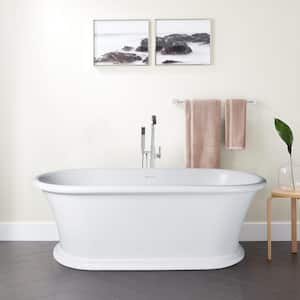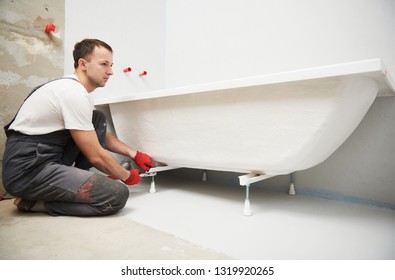Do It Yourself Bathtub Setup.
Do It Yourself Bathtub Setup.
Blog Article
Everybody will have their private beliefs when it comes to Installing A Bathtub.

Mounting a bath tub isn't exactly brain surgery, yet it does require solid plumbing, woodworking, and in some cases, tiling abilities. Replacing an old bath tub with a brand-new one is also a reasonably hard project. If the old tub is easily obtainable, the project can move immediately; if you need to open up a wall to eliminate the old bathtub and also place the brand-new bath tub, the task is much harder. In either situation, the job is within a residence handyman's abilities, although you will need a helper to move out the old tub as well as embeded in the brand-new one. See to it you have actually qualified yourself for the task as well as fit trying it. As opposed to hiring a contractor to take over a halfway-completed job, it is much better to take into consideration employing one before you begin. Possibilities are you may need an expert plumber to make tube links.
This post will certainly aid you set up a new tub in your shower room if you have currently gotten a new tub as well as don't need to alter the plan of your previous water system pipelines.
Your tools and material checklist should comprise the following:
Removing Old Touches
If you need to replace old taps with new ones as a part of your installation, after that the first thing you need to do is separate the water system. After doing so, switch on the faucets to drain any water remaining in the system. The process of eliminating the existing taps can be quite bothersome as a result of the limited gain access to that is typically the situation.
Use a basin wrench (crowsfoot spanner) or a faucet tool to reverse the nut that attaches the supply pipelines to the taps. Have a cloth all set for the continuing to be water that will certainly come from the pipes. As soon as the supply pipelines have been removed, make use of the same device to loosen up the nut that holds the taps onto the bath/basin. You will certainly need to stop the solitary taps from turning throughout this procedure. When the taps have actually been removed, the holes in the bath/basin will certainly have to be cleaned of any kind of old securing compound.
Prior to carrying on to fit the new taps, contrast the pipe links on the old faucets to the new faucets. If the old taps are longer than the brand-new faucets, then a shank adapter is needed for the new taps to fit.
Suitable New Taps
If the tails of the brand-new faucets are plastic, then you will require a plastic port to stop damage to the string. One end of the port fits on the plastic tail of the tap and also the other end gives a link to the existent supply pipelines.
If you need to fit a monobloc, after that you will require minimizing couplers, which attaches the 10mm pipe of the monobloc to the standard 15mm supply pipeline.
Next, place the tap in the placing hole in the bath/basin making certain that the washers remain in place in between the tap and also the sink. Safeguard the tap in position with the producer given backnut. When the faucet is safely in position, the supply pipes can be attached to the tails of the taps. The faucets can either be connected by utilizing corrugated copper piping or with regular tap ports. The previous type must be connected to the tap finishes first, tightening up only by hand. The supply pipes can later on be connected to the various other end. Tighten both ends with a spanner after both ends have actually been linked.
Mounting the Bathtub
Utilizing both wooden boards under its feet, put the bath tub in the needed placement. The wooden boards are valuable in equally spreading the weight of the tub over the location of the boards as opposed to focusing all the weight onto four tiny points.
The next objective is to ensure that the tub is leveled all round. This can be attained by examining the spirit level and also readjusting the feet on the bathtub up until the level reads level.
To set up faucets, fit the bottom of the furthest versatile faucet adapter to the appropriate supply pipeline by making a compression sign up with; after that do the same for the other tap.
Turn on the water system and also check all joints as well as brand-new pipework for leakages and also tighten them if necessary. Fill the tub and likewise inspect the overflow electrical outlet and also the normal outlet for leaks.
Lastly, take care of the bathroom paneling as defined in the manufacturer's instruction manual. Tiling and securing around the bathtub should wait until the tub has been made use of at the very least when as this will settle it into its final placement.
Planning for the Installment
Firstly, the supporting frame supplied with the bath should be fitted (if required) according to the manufacturer's instructions. Next, fit the taps or mixer to the bathtub. When fitting the faucet block, it is important to make sure that if the tap comes with a plastic washing machine, it is fitted in between the bathroom and also the faucets. On a plastic bath, it is also sensible to fit a supporting plate under the taps unit to stop stress on the bathtub.
Fit the flexible faucet adapters to the bottom of both faucets utilizing 2 nuts as well as olives (in some cases supplied with the bathtub). Fit the plug-hole electrical outlet by smearing mastic filler round the sink electrical outlet hole, and after that pass the outlet through the hole in the bathroom. Make use of the nut provided by the producer to fit the plug-hole. Examine the plug-hole electrical outlet for an inlet on the side for the overflow pipeline.
Next off, fit the end of the flexible overflow pipeline to the overflow electrical outlet. After that, screw the pipe to the overflow face which should be fitted inside the bath. Ensure you use every one of the provided washers.
Connect the catch to the bottom of the waste electrical outlet on the tub by winding the thread of the waste electrical outlet with silicone mastic or PTFE tape, as well as screw on the trap to the outlet. Attach all-time low of the overflow tube in a similar manner.The bath need to now be ready to be suited its final placement.
Tiling Around the Tub
In the area where the bathroom fulfills the ceramic tile, it is necessary to secure the joins with a silicone rubber caulking. This is important as the fitting can move sufficient to break a rigid seal, creating the water to permeate the wall in between the bath and also the tiling, causing problems with wetness as well as possible leakages to the ceiling listed below.
You can choose from a selection of coloured sealants to blend in your components and installations. They are sold in tubes and also cartridges, as well as can sealing gaps as much as a width of 3mm (1/8 inch). If you have a larger void to fill, you can load it with twists of drenched newspaper or soft rope. Bear in mind to always load the tub with water prior to sealing, to permit the motion experienced when the bathtub is in usage. The sealant can split fairly very early if you do not think about this motion prior to sealing.
Conversely, ceramic coving or quadrant tiles can be made use of to edge the bath or shower tray. Plastic strips of coving, which are easy to use and also cut to dimension, are additionally easily offered on the marketplace. It is a good idea to fit the ceramic tiles using waterproof or water resistant adhesive and also grout.
Bathtub Installation
How Important Is A Bathtub To Your Home?
High-quality baths, showers, and other bathroom updates are necessary when considering a smart investment in your home. It’s a room that you go to every day and one that is constantly being used by guests.The bathroom is one of the top trafficked rooms in a home and also one of the most valuable in terms of home resale.
Install Piping Before Tub
You will be using your existing drain and waste vent system, but pipes required include the hot and cold water supply lines and a pipe leading to a shower head. A mixing valve and shower head are also needed. Air chambers may be required.
Position the Tub
Lower the tub into place so that the continuous flange fits against the wall studs and rests on 1’x4' or 2’x4' supports. Anchor the tub to the enclosure with nails or screws inserted through the flanges into the studs.
NOTE: Remember, bathtubs and shower stalls may require support framing. A bathtub filled with water is extremely heavy, so check building codes and framing support before installing the tub.
Assemble Drain Connections
Assemble the bathtub drain connections by connecting the tub overflow with the tub drain above the trap, not beyond it. The trap will have a compression fitting that screws over the arm of the overflow assembly.
Place a Pipe For the Shower Head
First, locate a brass female threaded winged fitting and attach it to a framing support via a screw or a nail. Then run a pipe up the wall for the shower head. Sweat or solder the other side of the brass fitting to the top of the pipe.
Attaching Hot and Cold Water Lines
Attach your water lines for both hot and cold by sweating these directly into the hot and cold ports of the mixing valve. The mixing valve will be how water enters the tub’s system, not by the pipes themselves.
Install the Spout
Extend a piece of 1/2 inch pipe, or whichever length is specified in the manufacturer’s instructions, for the tub spout. Sweat on a male threaded fitting at the end of the pipe or use a brass nipple of the proper length and a 1/2 inch cap.
NOTE: At this point you should have your rough-in plumbing work inspected before proceeding further.
Check For Leaks
Restore the water pressure and check the drain connection and the supply pipes for any sign of leaking.
estore the Bathroom Wall
Replace the wall with moisture-resistant drywall as a base for your wall covering. Seal the joints between the wall and your new tub with silicone caulk as protection against water seepage.
https://www.berkeys.com/2016/12/02/bathtub-installation-dallas/

Do you enjoy more info about How to Install a Bathtub Yourself? Create a short review further down. We would be delighted to hear your thinking about this write up. We hope that you visit us again before long. Sharing is nice. Helping people is fun. We truly appreciate reading our article about How to Install a Bathtub.
Book My Estimate Report this page